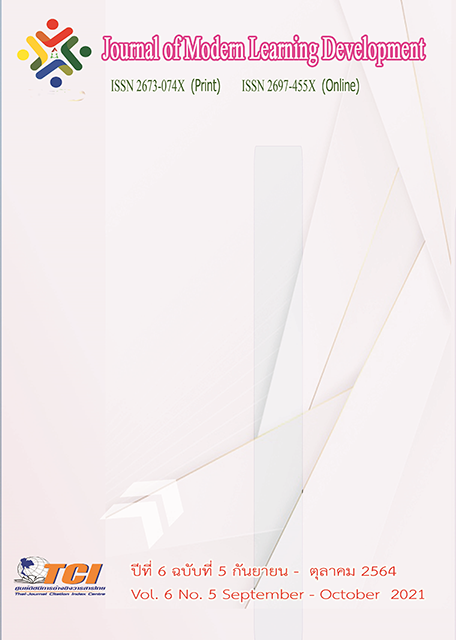Creating a Tool to Assess Learning about Solving Math Problems for Mathayomsuksa 1 Students
Main Article Content
Abstract
This research had objectives to 1) create learning assessment tools in mathematics problem solving for Mathayomsuksa 1 students and 2) evaluate the quality of learning assessment tool in Mathematics Problem Solving for Mathayomsuksa 1 students as used in the lessons according to Polya’s problem solving steps. The target group was a class of 39 Mathayomsuksa 1 students in second semester of academic year 2020 from Nanongtoomwittaya school, the Secondary Educational Service Area Office Chaiyaphum Province. A sampling method was cluster random sampling. There were 3 research tools, 1. Test 2. Self-assessment form and 3. Reflection record form. Statistics for data analysis included Index of Item Objective Congruence (IOC), reliability, difficulty, and discrimination.
The result showed that
1. Assessment tools for learning consisted of ;
1.1 Test, 20 multiple choices with 4 choice in each question
1.2 Self-evaluation form for students in order to evaluate the aspects of opinion, feeling, and behavior in mathematics problem solving in 20 questions
1.3 Reflection record form for Mathayomsuksa 1 students’ reflection in mathematics problem solving in the aspects of opinion, knowledge, skills, and interpersonal relationship that influenced mathematics problem solving in 15 questions
2. Result of the quality evaluation of learning assessment tool
2.1 Test in mathematics problem solving for Mathayomsuksa 1 students with 20 questions with difficult value ranged from 0.48 – 0.74, discrimination value ranged from 0.21 – 0.58 and the overall reliability valued at 0.88
2.2 Self-evaluation form for students in the aspects of opinion, feeling, and behavior for mathematics problem solving in 20 questions in order to do self-evaluation, after learning discrimination value in each question ranged 0.41 – 0.71 whereas the overall reliability valued at 0.90
2.3 Reflection record form for mathematics problem solving of Mathayomsuksa 1 students in the aspects of opinion, knowledge, skills, and interpersonal relationship that influenced mathematics problem solving in 15 questions
Article Details
References
กาญจนา ธานะ. (2556). รายงานการศึกษาความพึงพอใจของนักศึกษาคณะพยาบาลศาสตร์แมคคอร์มิคต่อการจัดการเรียนการสอนโดยใช้วิธีการสะท้อนคิด รายวิชาการฝึกปฏิบัติการพยาบาลพื้นฐานภาคเรียนที่ 2 ปี การศึกษา 2555. เชียงใหม่: มหาวิทยาลัยพายัพ.
งานวิชาการโรงเรียนนาหนองทุ่มวิทยา. (2561). รายงานกลุ่มงานวิชาการโรงเรียนนาหนองทุ่มวิทยา. ชัยภูมิ:โรงเรียนนาหนองทุ่มวิทยา.
จิตติมา พิศาภาค. (2552). การพัฒนาความสามารถในการแก้โจทย์ปัญหาคณิตศาสตร์ ของนักเรียนชั้นประถมศึกษาปีที่ 2 โรงเรียนสาธิตแห่งมหาวิทยาลัยเกษตรศาสตร์ ศูนย์วิจัยและพัฒนาการศึกษา โดยใช้กระบวนการแก้ปัญหาตามแนวคิดของโพลยา. วิทยานิพนธ์วิทยาศาสตรมหาบัณฑิต. มหาวิทยาลัยเกษตรศาสตร์. บัณฑิตวิทยาลัย: มหาวิทยาลัยเกษตรศาสตร์.
ดวงพรตั้งอุดมชัยเจริญ. (2551). การศึกษาผลสัมฤทธิ์ทางการเรียนวิชาคณิตศาสตร์ในการแก้โจทย์ปัญหาโดยใช้ขั้นตอนของโพลยาสำหรับนักเรียนชั้นประถมศึกษาปีที่ 4. วิทยานิพนธ์ครุศาสตรมหาบัณฑิต. บัณฑิตวิทยาลัย: มหาวิทยาลัยราชภัฏราชนครินทร์.
ทิศนาแขมมณี. (2553). ศาสตร์การสอนองค์ความรู้เพื่อการจัดกระบวนการเรียนรู้ที่มีประสิทธิภาพ. กรุงเทพมหานคร: ด่านสุทธาการพิมพ์
วัลลภา เทพหัสดิน ณ อยุธยา. (2543). การพัฒนาการเรียนการสอน. กรุงเทพมหานคร: จุฬาลงกรณ์มหาวิทยาลัย.
สมพร สีตาล. (2559). การพัฒนาชุดฝึกทักษะ เพื่อส่งเสริมการเรียนรู้ โจทย์ปัญหาทางคณิตศาสตร์ ของนักเรียนชั้นประถมศึกษาปีที่3โรงเรียนประชาอุปถัมภ์. วิทยานิพนธ์ปริญญามหาบัณฑิต. สาขาหลักสูตรและการสอน. บัณฑิตวิทยาลัย: มหาวิทยาลัยธุรกิจบัณฑิตย์.
สํานักวิชาการและมาตรฐานการศึกษา.สํานักงานคณะกรรมการการศึกษาขั้นพื้นฐาน. (2552). แนวปฏิบัติการวัดและประเมินผลการเรียนรู้ตามหลักสูตรแกนกลางการศึกษาขั้นพื้นฐานพุทธศักราช 2551.กรุงเทพมหานคร: โรงพิมพ์ชุมนุมสหกรณ์การเกษตรแห่งประเทศไทยจํากัด.
สำนักงานราชบัณฑิตยสภา. (2559). พจนานุกรมศัพท์ศึกษาศาสตร์ร่วมสมัยชุดการประเมินและวิจัยฉบับราชบัณฑิตยสภา. กรุงเทพมหานคร: สำนักงานราชบัณฑิตยสภา.
สิริพรทิพย์คง. (2545). หลักสูตรและการสอนคณิตศาสตร์. กรุงเทพมหานคร: บริษัทพัฒนาคุณภาพวิชาการจำกัด.
สุริยันต์ลาภเย็น. (2559). การใช้การประเมินเพื่อการเรียนรู้เพื่อส่งเสริมผลการเรียนรู้ในรายวิชาฟิสิกส์ของนักเรียนชั้นมัธยมศึกษาปีที่5 โรงเรียนนวมินทราชินูทิศสตรีวิทยา 2. ออนไลน์. สืบค้นเมื่อ 12 มกราคม2564. แหล่งที่มา: http://www.sci.rmutt.ac.th/stj/index.php/stj/article/view/317
โสมภิลัยสุวรรณ. (2554). การพัฒนาความสามารถในการแก้โจทย์ปัญหาเศษส่วนโดยใช้กระบวนการแก้ปัญหาของโพลยาสำหรับนักเรียนชั้นประถมศึกษาปีที่ 6 โรงเรียนอนุบาลลำพูน. วิทยานิพนธ์ศึกษาศาสตรมหาบัณฑิต. บัณฑิตวิทยาลัย: มหาวิทยาลัยเชียงใหม่.
Polya George. (1957). How to Slove it. New Jersey. Princeton University Press.
Aravena D.M. & Caamano E.C. (2008). The method of problem solving based on the Japanese and Polya’s models A classroom experience in Chilean School. Chile. (Mathematics Department Basic Sciences Institute), Catholis University of Talca - Chile.
Black. P. & Wiliam, D. (2002). Inside the black bok: Raising standards through classroom assessment. London, UK: King College London school of Education.
Assessmen Reform Group. (2002). Assessment for learning: Beyond the black box. University of Cambridge Faculty.


